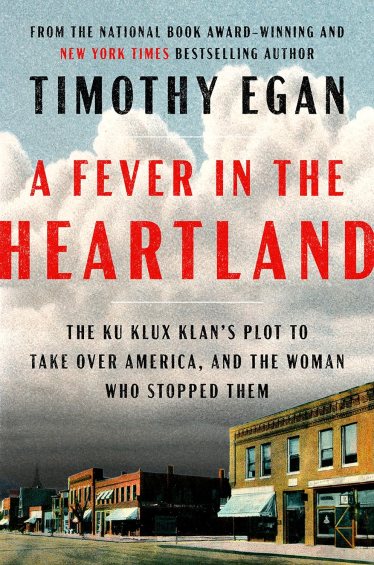Book Review | ‘A Fever in the Heartland: The Ku Klux Klan’s Plot to Take Over America, and the Woman Who Stopped Them’ by Timothy Egan
How a Con Man Became One of the Most Powerful People in 1920s America

“It was the damnedest thing I ever saw,” says the aide to the great man, “how this guy could spread the bunk and make the hicks eat it up.” Readers could be forgiven for thinking this quote refers to Donald Trump, circa 2023, but in fact it is spoken by Court Asher, a strongman and bootlegger “always keen to a new con,” describing his boss, DC “Steve” Stephenson, Grand Dragon of the Indiana Ku Klux Klan in 1923.
Like Trump, Stephenson aspired to be President, though the latter is now all but forgotten, along with the millions of American Klansman he inspired in the first half of the Roaring Twenties. Of this mass amnesia, Timothy Egan writes in A Fever in the Heartland: The Ku Klux Klan’s Plot to Take Over America, and the Woman Who Stopped Them, “When the grandchildren of these leading citizens later discovered hoods in the attic, or membership lists that included their kin, they could not fathom how such a thing had come to pass.” Egan’s book explains it all.
The ambitious Stephenson’s central epiphany was “he could make far more money from the renewable hate of everyday white people than he could ever make as an honest businessman or a member of Congress.” A drifter and con man from Texas, he winds up in Evansville, Indiana, just across the border from Kentucky, but one of Egan’s primary concerns is to show that in the 1920s, the real strength of the Klan was not in the South but in the “Heartland” of the book’s title, and in the West as well: California, Colorado, and Oregon all demonstrate their fair share of racism and violence.
The first half of the book charts Stephenson’s rise in the Klan, so that he is second only in power to the Imperial Wizard, a dentist from Dallas named Hiram Wesley Evans. The hypocrisy of the Klan is stunning, especially as it is practiced by Stephenson. While the “fraternal order” claims to be the great protector of white womanhood, Stephenson is a serial rapist who especially delights in biting his victims until they bleed. He gets away with this because, as he tells everyone, thanks to his masterful manipulation of state and local politicians, “I am the law.”
Finally, however, he reaches too far. Madge Oberholtzer, a young woman who lives on the same street in Stephenson’s affluent Indianapolis suburb, gets to know Stephenson in an effort to write a book about nutrition for Indiana’s schools. By all accounts — except those of Stephenson and his cronies — the relationship is chaste, with Madge wary of “the Old Man,” but hopeful that he can help advance her career.
But Stephenson is not interested in Madge’s thoughts on nutrition. Instead, he and two henchman kidnap her at gunpoint then stow her on the night train to Chicago, where Stephenson beats and rapes her and bites her so savagely that she later develops sepsis. Stephenson and his crew deboard the train just before it crosses the Illinois state line, where they continue to hold her captive until, in desperation, she swallows six tablets of bichloride of mercury, “a highly toxic poison and household disinfectant.” Ultimately, she is returned to her parents’ home, but it’s clear the damage has been done: she is dying a slow, painful death. Before she dies, though, she gives a detailed witness statement, which is later used against Stephenson in court.
The trial itself seems like something out of a movie, with the suave yet shady defense lawyer up against the nervous but scrupulously honest prosecutor. These pages may go on a bit long, especially as the book’s title, and the fact that Stephenson is now unremembered, signal the verdict. Nevertheless, after all the horror “Steve” has inflicted on those who fought against him, it’s satisfying to see his comeuppance.
“Democracy was a fragile thing, stable and steady until it was broken and trampled,” Egan writes, summarizing the aftermath of Stephenson’s four years of corruption and cruelty. “A man who didn’t care about shattering every convention, and then found new ways to vandalize the contract that allowed free people to govern themselves, could do unthinkable damage.” Again, the similarity to the reign of Donald Trump is unmistakable, and in the book’s epilogue, Egan finally comes out and says what’s been obvious all along: “What if the leaders of the 1920s Klan didn’t drive public sentiment, but rode it? A vein of hatred was always there for the tapping. It’s there still, and explains much of the madness threatening American life a hundred years after Stephenson made a mockery of the moral principles of the Heartland.”
In the late summer of 2023, we have no way of knowing whether David C. Stephenson’s fate presages the fall of Trump, or will serve as a counterexample that good triumphs over evil. We can only hope that once again our fellow citizens will come to their senses before it’s too late.
This review originally appeared in the California Review of Books.




You must be logged in to post a comment.